
![]() What
do Cleopatra, Empress Josephine and George Washington have in common?
They all loved roses. When she met Anthony for the first time, it is said
that Cleopatra filled the room with rose petals. Empress Josephine, wife
of Napoleon Bonaparte, was so enamored of roses that she planted more
than two hundred fifty different varieties in her Paris garden. And Washington
was the first American breeder of roses at his home at Mount Vernon. One
of the varieties, named for his mother, is still being grown today.
What
do Cleopatra, Empress Josephine and George Washington have in common?
They all loved roses. When she met Anthony for the first time, it is said
that Cleopatra filled the room with rose petals. Empress Josephine, wife
of Napoleon Bonaparte, was so enamored of roses that she planted more
than two hundred fifty different varieties in her Paris garden. And Washington
was the first American breeder of roses at his home at Mount Vernon. One
of the varieties, named for his mother, is still being grown today.
Our love affair with roses is never-ending. They are the flower of love and friendship. Nothing says this like a bouquet of long-stemmed, red roses. On February 14, it seems as though all of us want to show our feelings by the gift of this very special flower. It is estimated that more than eighty-four million roses will be sold this Valentine's Day all over the United States.
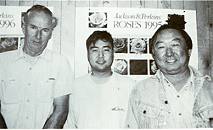 In
Waimea, roses have a special significance. A small group of farmers harvest
more than nine million roses a year, giving our community the distinction
of being the biggest rose producer in the state. It is a difficult and
competitive business. The Waimea growers are faced with the challenges
of climate and plant disease, shipment by air and increasing competition
from large growers in South America whose huge roses are making deep inroads
into the U. S. market.
In
Waimea, roses have a special significance. A small group of farmers harvest
more than nine million roses a year, giving our community the distinction
of being the biggest rose producer in the state. It is a difficult and
competitive business. The Waimea growers are faced with the challenges
of climate and plant disease, shipment by air and increasing competition
from large growers in South America whose huge roses are making deep inroads
into the U. S. market.
There are four farms in Waimea currently growing roses. They are Kawamata Farms, J and D Farms, Leland Sung Farms and Watanabe Florals. Miniature roses, grown by the Yoshikami family, are also made into delicate arrangements and sold locally. Watanabe's, the largest grower, is located just below the tree nurseries on Lalamilo Road. Although we think of them as a local business; the company actually began on O'ahu when Ernest and Shizue Watanabe started their first farm on Farmers Road in Waialae- Kahala in 1946. In 1979, they expanded to Waimea when affordable agricultural land became scarce in Honolulu. Waimea's elevation of twenty-six hundred feet, with its lower temperatures and bright sunshine, is ideal for the growing of roses. The Watanabe family harvests twenty-three different varieties of roses on their sixteen acres of land in Waimea, employing thirty five workers to handle the farm and its rose production.
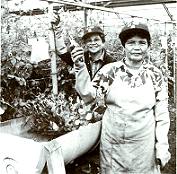 Rose
farms are busy places. Because the roses never stop growing, the work
must go on seven days a week. At Watanabe's, the day begins early when
the first group of workers arrive at 7:00 a.m. to begin the twice-daily
harvesting of roses in the eight greenhouses filled with colorful varieties.
In the cool, early morning, women with huge gloves move rapidly up and
down the rows. They cut the long stems whose blossoms are just beginning
to open and bundle them in their arms like babies. In the background,
soft music plays because the workers believe that the music nurtures the
roses as much as their daily dose of fertilizer and water. As they work,
a supervisor moves from building to building, looking for problems and
checking for spots on leaves that indicate that a disease may have attacked
the precious plants.
Rose
farms are busy places. Because the roses never stop growing, the work
must go on seven days a week. At Watanabe's, the day begins early when
the first group of workers arrive at 7:00 a.m. to begin the twice-daily
harvesting of roses in the eight greenhouses filled with colorful varieties.
In the cool, early morning, women with huge gloves move rapidly up and
down the rows. They cut the long stems whose blossoms are just beginning
to open and bundle them in their arms like babies. In the background,
soft music plays because the workers believe that the music nurtures the
roses as much as their daily dose of fertilizer and water. As they work,
a supervisor moves from building to building, looking for problems and
checking for spots on leaves that indicate that a disease may have attacked
the precious plants.
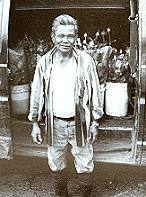 By
9:00 a.m., the first cuttings have been placed in big, water-filled buckets.
Male employees are busy moving about in vans to collect and deposit the
fresh cuttings in the warehouse. When they are not helping with the flower
collection, they also build and repair greenhouses, maintain the fertilizing
and watering systems, and spray to prevent disease on the plants. By the
time the flowers have arrived, everyone is ready for the first break of
the day when they gather for a snack, while relaxing and "talking story."
By
9:00 a.m., the first cuttings have been placed in big, water-filled buckets.
Male employees are busy moving about in vans to collect and deposit the
fresh cuttings in the warehouse. When they are not helping with the flower
collection, they also build and repair greenhouses, maintain the fertilizing
and watering systems, and spray to prevent disease on the plants. By the
time the flowers have arrived, everyone is ready for the first break of
the day when they gather for a snack, while relaxing and "talking story."
Almost all of Watanabe's employees are first- generation immigrants from the Philippines. They come primarily from the provinces of Ilocos Norte and Isabella.
The majority are children of rice farmers and are used to hard work. In a recent interview, Watanabe's manager, David Oshiro, praised his employees, saying that " . .. they are dependable, honest and loyal workers. We have hardly any turnover. And most of our people somehow manage to send money home to the Philippines in addition to saving to bring over other members of their family."
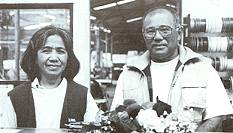 The
group is close-knit and well-disciplined. Several workers have been at
Watanabe's for more than eighteen years. Francine Dela Cruz is a familiar
face for many Watanabe customers in Waimea since she handles retail flower
sales at the front of the warehouse. Trained as a teacher in the Philippines,
Francine also works part-time at Waimea School. In the back, Norma Bala,
another longtime employee, over- sees the daily picking and sorting operation
and helps to maintain harmony among the workers. Often, employees are
members of the same family. It is common to find husband and wife, and
even their children, all working together. Twelve of workers are grandmothers.
The newest arrivals are only eighteen years of age.
The
group is close-knit and well-disciplined. Several workers have been at
Watanabe's for more than eighteen years. Francine Dela Cruz is a familiar
face for many Watanabe customers in Waimea since she handles retail flower
sales at the front of the warehouse. Trained as a teacher in the Philippines,
Francine also works part-time at Waimea School. In the back, Norma Bala,
another longtime employee, over- sees the daily picking and sorting operation
and helps to maintain harmony among the workers. Often, employees are
members of the same family. It is common to find husband and wife, and
even their children, all working together. Twelve of workers are grandmothers.
The newest arrivals are only eighteen years of age.
| Roses have been eaten in various forms for centuries. The earliest recorded rose recipe was a rose candy that was eaten by ancient Romans who enjoyed great variety in their food. Roses had so many uses that in the final days of the Roman Empire, Emperor Nero gave feasts while guests lounged on pillows stuffed with rose petals, bathed in marble pools filled with rose-perfumed water, drank great amounts of rose wine and ate rose pudding for dessert. Further to the East, the Persians exported rose water to most of Europe, Asia and Africa. Rose water was used as a flavoring for cakes, cookies and pastries. Throughout the centuries, roses, like spices, have traveled throughout the world. And although native roses grew in the America's, the recipe for "Quail in Rose Petal Sauce" in the book, Like Water for Chocolate, was probably brought over by the Spanish (You may recall how Tita's rose-infused food made the guests at her sister's wedding weep uncontrollably.). Today, although we most often use roses as floral decoration for wedding cakes and to adorn our dining tables, they still provide excellent flavoring for sauces, teas, pastries and delicate meat or poultry dishes. * Note: Be sure never to use roses that have been treated with insecticides or fungicides for cooking. 1. When you first receive or buy your roses, remove any leaves that will be below the water line of the vase or other container you'll be using. Be careful not to cut or scrape the green bark of the stem - air can enter the water-conducting passages through these injuries and clog up the stems. 2. Submerge the stems in water and cut off about one inch from each stem with a very sharp knife, being sure to make the cut under the water. 3. Immediately place the roses in the water-filled container, never allowing the ends to dry. A floral preservative added to the water will help to make your roses last longer. 4. If any of the roses seem limp, you can revive them by recutting the stems underwater and laying the entire rose in barely warm water in a sink or tub. After an hour or two, the rose will revive and can be put back into the arrangement. 5. Keep roses out of drafts and in a cool, dark place at night. 6. Roses are heavy drinkers. Give them lots of water and change the water in the vase when it becomes cloudy. |
Watanabe Florals and the other rose growers and farms in Waimea have also helped to provide employment for workers who have been displaced by the closing of Hamakua Sugar. Others have moved up the hill from the hotels where they have found the employment to be too seasonal and transportation too burdensome. Waimea's farms offer steady employment for these hard workers. Working primarily in the greenhouses and in the fields, they are part of the hidden labor force which is such an important part of Waimea's economy.
After a short break, the picking crews return to the greenhouses, while the sorters begin sorting and grading the different varieties of freshly picked roses. The roses are then packed in ice in huge boxes and are loaded for shipment to the main facility in Honolulu. Twice a day, drivers make the trip down the hill to Kona Airport where the roses are loaded onto the first available Hawaiian Airlines flight to Honolulu. There the shipments are met by other Watanabe's employees and rushed to the warehouse for immediate sorting and distribution on 0'ahu. Eighty-five percent of the roses grown in Waimea are sent to Honolulu. The majority are sold wholesale to florists. As in Waimea, however, some are sold directly to the public out of Watanabe's Kalihi warehouse.
Throughout the state, local growers are struggling to survive. Their primary competition are the roses imported from South America. Grown high in the Andes mountains in Equador and Columbia at altitudes of ten thousand feet, these slower-growing rose plants produce huge blossoms with long stems. Since workers earn less than ten dollars a day, labor and production costs are extremely low on these farms. Government controls are also less stringent on the amount and types of pesticides that can be used. It takes two to three days for the South American roses to reach Miami from Columbia, then another two days over land to reach the West Coast. Roses are sent out by air on the day of arrival if possible, but almost a week goes by before they finally arrive in Hawai'i. Despite the lack of freshness, these imported roses still sell for sixty-five to eighty-five dollars a dozen in local flower shops.
Hawai'i's growers have watched their market share drop as the South American roses have taken over. They now command forty-five percent of the market. Down the road from Watanabe's, another long-term grower, Raymond Kawamata, after watching his business drop off forty percent in the past two years, pulled up many of his rose plants. Kawamata is a second generation grower in Waimea whose father started with vegetables and successfully converted to roses when the competition was statewide. Faced with the recent decline in rose sales, he decided to convert part of his farm back to vegetables. Kawamata's first new crop was tomatoes. Now he is expanding into red and yellow peppers and the gourmet cucumbers. In his choice of new plantings, Kawamata has been strongly influenced by local chefs who are looking for fresh and flavorful vegetables to use in their island cuisine.
Responding to the challenge, Watanabe's decided to continue with roses, but to concentrate on the shorter, ten to twenty-two inch sizes that are not imported. They also sell roses at a much lower price, hoping that customers will buy their many varieties more frequently than just for special occasions and holidays when roses are the tradition gift.
 Nevertheless,
Waimea's rose farmers still depend on the "big days" for maximum sales
of their flowers. Mother's day, graduation and Valentine's Day are the
most important times. Growth is controlled to produce the largest possible
amount of roses at these times. Valentine's Day is the most challenging
sales occasion for the grower. "I wish it were in the middle of the summer,"
Oshiro said wistfully, as he gazed over at his calendar. He explained
that flower production slows down as a result of the colder days and longer
nights of the Waimea winter.
Nevertheless,
Waimea's rose farmers still depend on the "big days" for maximum sales
of their flowers. Mother's day, graduation and Valentine's Day are the
most important times. Growth is controlled to produce the largest possible
amount of roses at these times. Valentine's Day is the most challenging
sales occasion for the grower. "I wish it were in the middle of the summer,"
Oshiro said wistfully, as he gazed over at his calendar. He explained
that flower production slows down as a result of the colder days and longer
nights of the Waimea winter.
At Watanabe's, preparation for Valentine's Day began back in December when workers pinched back the rose plants, debudding them to slow production so that there would be maximum blossoming the second week of February. But Mother Nature is impossible to predict, and Oshiro says that is a "hit or miss" proposition. In the summer, it takes forty-two to forty-five days to grow and harvest the rose flowers. In winter, it takes forty- five to sixty days. The colder the nights, the longer the stem and the larger the flower, but if the grower misses the target date of February 10 to 12, then it may be too late to sell all the flowers. After all, who wants roses on February 15th?
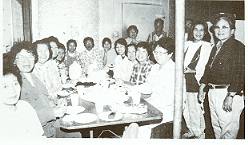 For
the workers in Waimea's rose farms, the month of February is spent giving
careful attention to the plants, nurturing the blossoms in order to provide
the greatest yield for the holiday. It means: long days of cutting, packing
and shipping as many' roses as possible. If you are among those lucky
enough to receive roses on Valentine's Day, whether they be from our community
or elsewhere, all those who have cared for the delicate blossoms hope
that their efforts will be appreciated and the flowers will last long!
For
the workers in Waimea's rose farms, the month of February is spent giving
careful attention to the plants, nurturing the blossoms in order to provide
the greatest yield for the holiday. It means: long days of cutting, packing
and shipping as many' roses as possible. If you are among those lucky
enough to receive roses on Valentine's Day, whether they be from our community
or elsewhere, all those who have cared for the delicate blossoms hope
that their efforts will be appreciated and the flowers will last long!